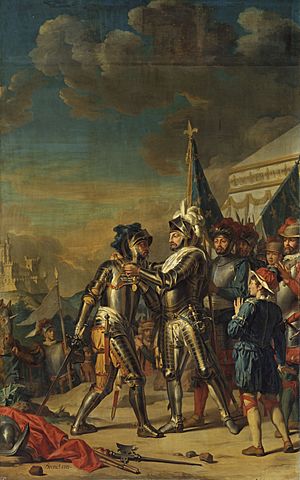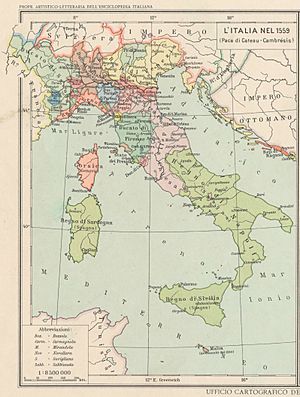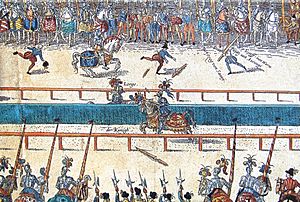Italian War of 1551–1559 facts for kids
Quick facts for kids Italian War of 1551–1559 |
|||||||||
|---|---|---|---|---|---|---|---|---|---|
| Part of the Italian Wars | |||||||||
 The Battle of Scannagallo in 1554 by Giorgio Vasari, in the Palazzo Vecchio of Florence |
|||||||||
|
|||||||||
| Belligerents | |||||||||
|
|
||||||||
| Commanders and leaders | |||||||||
|
|||||||||
The Italian War of 1551–1559 was a big conflict in Europe. It is also known as the Habsburg–Valois War or the Last Italian War. It began in 1551 when Henry II of France declared war on Emperor Charles V. Henry II wanted to take back parts of Italy. He also wanted France, not the Habsburg family, to be the most powerful in Europe.
The war ended in 1559 with the Treaty of Cateau-Cambrésis. This treaty was signed by the leaders of Spain, England, and France. During this war, new gunpowder weapons and stronger forts were very important. Soldiers also became more professional.
Contents
Key Events of the War
This is a quick look at important events and battles during the war.
Before the War (1547–1551)
- In 1547, Pier Luigi Farnese, Duke of Parma was killed. Emperor Charles V's troops then took over the Duchy of Parma.
- In 1550, a new Pope, Pope Julius III, became leader. He said that Ottavio Farnese owned Parma. This made Emperor Charles V angry.
- In 1550, Henry II of France made a deal with the Ottoman Empire. They agreed to be allies.
- In 1551, Henry II of France and Ottavio Farnese signed a deal. France would protect Parma.
First Part of the War (1551–1556)
- In June 1551, the War of Parma started. Emperor Charles V and Pope Julius III fought against Henry II of France and Ottavio Farnese.
- In July 1551, the Ottomans won a battle against the Knights Hospitaller at Gozo.
- In August 1551, the Ottomans captured Tripoli from the Knights Hospitaller.
- From 1551 to 1552, French and Parma forces won the Siege of Mirandola (1551).
- In 1552, Henry II of France made an alliance with German Protestant princes against Charles V. This was called the Treaty of Chambord.
- In 1552, a two-year peace deal ended the War of Parma.
- From March to August 1552, the Second Schmalkaldic War happened. The German princes, allied with France, defeated Charles V. Henry II took over three important cities: Metz, Toul, and Verdun.
- In July 1552, French and Ottoman forces attacked Reggio in Southern Italy. They won against Spain.
- In August 1552, French and Ottoman forces won the Battle of Ponza (1552) against Genoa.
- In July 1552, people in Siena rebelled against Spain.
- In October 1552, France won the Siege of Metz (1552) against the Emperor's army.
- From 1553 to 1559, Ottomans and French forces took over most of Corsica.
- In August 1554, the Battle of Marciano (also called Scannagallo) was a big win for Florence and Spain. They defeated Siena and France.
- From January 1554 to April 1555, the Siege of Siena happened. Spain won, and the Republic of Siena ended. Its land became part of Florence.
Short Break in Fighting (1556)
- In February 1556, a truce was signed between Charles V and Henry II of France. It was called the Truce of Vaucelles.
- Charles V gave up his power. His son, Philip II, became King of Spain. His brother, Ferdinand I, became Holy Roman Emperor.
Second Part of the War (1556–1559)
- In September 1556, Spain invaded the Papal States.
- In August 1557, Spain won the Siege of Civitella against France.
- In August 1557, Spain, Savoy, and England won the Battle of St. Quentin (1557) against France.
- In September 1557, Pope Paul IV signed a separate peace deal with Spain.
- In January 1558, France won the Siege of Calais (1558) against England. This was a big loss for England.
- From April to June 1558, France won the Siege of Thionville (1558) against the Imperial-Spanish army.
- In July 1558, the Ottomans raided the Balearic Islands and won against Spain.
- In July 1558, England and Spain won the Battle of Gravelines (1558) against France.
- In September 1558, Charles V died.
- In April 1559, the Peace treaties of Cateau-Cambrésis were signed.
- In July 1559, Henry II died from injuries in a jousting accident. This happened during the celebrations for the peace treaty.
How the War Was Fought
Fighting in the Mediterranean Sea

Henry II of France made a special deal with Suleiman the Magnificent, the leader of the Ottoman Empire. They agreed to work together against the Habsburgs in the Mediterranean Sea. This alliance helped France attack areas near the Rhine River. Meanwhile, a combined French and Ottoman fleet protected southern France.
In 1551, Ottoman forces attacked Tripoli. French ships from Marseille joined the Ottoman fleet. In 1552, when Henry II attacked Charles V, the Ottomans sent many ships. These ships, along with three French ships, raided the coast of Southern Italy. They captured the city of Reggio.
Later, in the Battle of Ponza, the French and Ottoman fleet defeated the Genoese ships. This alliance also led to the combined invasion of Corsica in 1553. The Ottomans kept attacking Habsburg lands in the Mediterranean. One example is the Ottoman invasion of the Balearic Islands in 1558, which Henry II had asked for.
Fighting on Land
The War of Parma
The war started on land because of a problem in Parma. The new Pope, Pope Julius III, said Ottavio Farnese was the rightful Duke of Parma. But Charles V's troops had taken over the city in 1547. Ottavio Farnese decided to ally with Henry II of France in May 1551. France would protect Parma.
Charles V did not like this. He convinced the Pope to join him against France and Parma. This started the War of Parma in June 1551. A key battle was the Siege of Mirandola (1551). French and Parma defenders successfully fought off attacks from the Pope's, Emperor's, and Spanish forces. A two-year truce ended this part of the war in April 1552.
German and Sienese Conflicts
Henry II also made a deal with German Protestant princes in 1552. This was the Treaty of Chambord. France successfully attacked Lorraine. Henry captured the cities of Metz, Toul, and Verdun. He kept them by defeating the Habsburg army at the Battle of Renty in 1554.
In 1552, people in the Republic of Siena rebelled against Spain. Henry II gained another ally. A French and Sienese army kicked out the Spanish soldiers. Siena welcomed French troops to protect them. In 1553, a French army went into Tuscany to help Siena.
In January 1554, the Spanish began to surround Siena. The French troops were attacked by an army from the Emperor and Florence. They were defeated at the Battle of Marciano in August 1554. After a long siege, Siena fell to Spanish forces in April 1555. The land of Siena later became part of the Duchy of Florence in 1559.
Papal States and St. Quentin
A peace deal was signed in 1556 between Charles V and Henry II. But it did not last long. After Charles V gave up his power, his empire was split. Philip II of Spain became King of Spain. Ferdinand I became Holy Roman Emperor. The war then focused on Flanders.
Pope Paul IV was unhappy and asked Henry II to join him in attacking Spanish Naples. In September 1556, Philip II attacked the Papal States first. French forces coming from the north were defeated at the Siege of Civitella in August 1557. Philip, with the help of Emmanuel Philibert, Duke of Savoy, defeated the French at the Battle of St. Quentin (1557) in August 1557.
The Spanish tried to block Rome by taking over the port of Ostia. But the Papal armies pushed them back. When French troops could not help, the Papal armies were defeated. Spanish troops reached the edge of Rome. To avoid another attack on Rome, Pope Paul IV agreed to a peace deal. The Papal States became neutral in September 1557.
England Joins and Gravelines
A small rebellion in England, supported by France, led to England joining the war. Queen Mary I declared war on France in June 1557. English troops helped win the battle at St. Quentin. But England's entry into the war led to the French Siege of Calais in January 1558. This was a big defeat for England.
French armies attacked Spanish lands in the Low Countries. They also won the Siege of Thionville in 1558. However, Henry II lost badly at the Battle of Gravelines in July 1558. This forced him to agree to a peace deal. He gave up any claims to Italy.
The war ended for other reasons too. Both Spain and France ran out of money in 1557. Also, Henry II had to deal with a growing Protestant movement in France. He wanted to stop it.
Treaty of Cateau-Cambrésis (1559)
What the Treaty Did
The Treaty of Cateau-Cambrésis (1559) was actually two treaties. The first was signed by Elizabeth I of England and Henry II of France on April 2. The second was signed by Henry II of France and Philip II of Spain on April 3. These treaties officially ended the wars between the Emperor and France. They also ended the long conflict between the Habsburg and Valois families. The leaders did not meet in person. Instead, their representatives signed the agreements.
What Happened After the War
After the war, there were some important marriages. Emmanuel Philibert, Duke of Savoy married Margaret of France, Duchess of Berry, who was Henry II's sister. Philip II of Spain married Elisabeth, Henry II's daughter.
During a tournament to celebrate the peace, King Henry II was badly hurt. On July 1, a piece of a broken lance went into his eye and brain. He died ten days later, on July 10, 1559. His 15-year-old son, Francis II, became king. But he also died soon after, in December 1560. His 10-year-old brother, Charles, then became king.
This caused a lot of political problems in France. Many soldiers were also out of work and not paid. These issues led to the start of the French Wars of Religion in 1562. These wars would last for the next thirty years in France.
After the war, Italy was divided. The Spanish Habsburgs ruled in the south. The Austrian Habsburgs had control in the north. Different families ruled other areas, like the Medici in Tuscany and the House of Savoy in Piedmont. The Pope kept a lot of cultural and political power in central Italy.
This situation in Italy lasted until the 1700s. Then, northern Italy went to the Austrian Habsburgs. Southern Italy went to the Spanish Bourbons.
See also
 In Spanish: Guerra italiana de 1551-1559 para niños
In Spanish: Guerra italiana de 1551-1559 para niños
- Elizabeth I of England
- Franco-Ottoman alliance
- States of Italy in 1559



